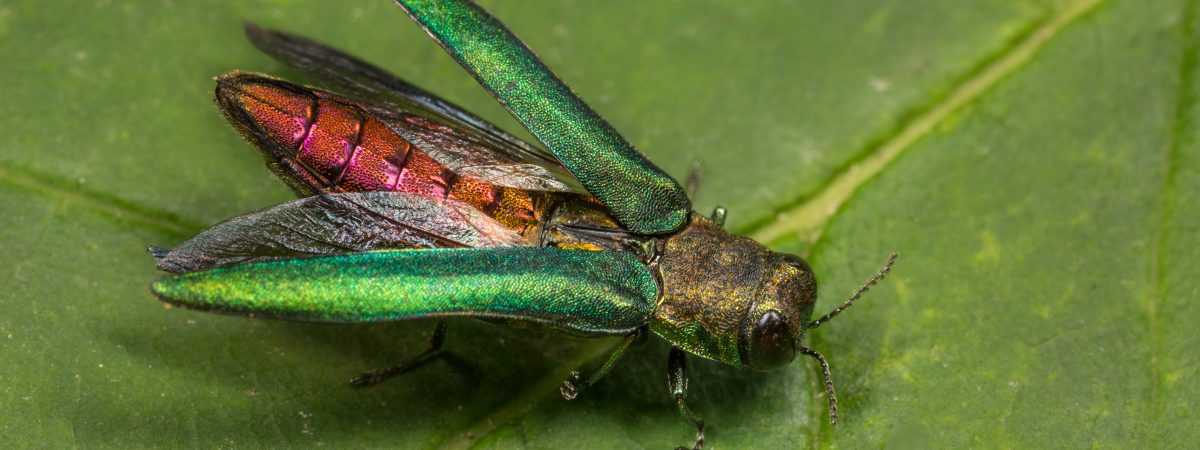Plant Health Care and the Emerald Ash Borer Life Cycle in Colorado Ash Trees
From Egg to Invading: The Full Emerald Ash Borer Life Cycle
The Emerald Ash Borer or more commonly referred to as EAB goes through many cycles before emerging as a mature adult. Continue reading to learn more about each part of the invasive pests life cycle.
Eggs
Eggs are approximately 1mm in size and laid by females in the cracks and crevices of the bark of ash trees. Females can lay anywhere from 40 to 200 eggs that will hatch about two weeks later. Upon hatching the larvae will then burrow into the trees inner bark layers and begin to feed.
Larvae
The larval stage is the most dangerous stage of the beetles life. Larvae tunnel into the bark upon hatching from their eggs. They then spend all of their time eating tissues that the tree would need to transport water and nutrients. This damage of vital tissues can quickly become deadly to the ash tree because of the number of larvae doing damage and their aggressive nature. As they feed their movements form a distinct S-shaped pattern which can be seen when bark is removed. This is the stage most often selected to chemically treat an infestation as the larvae will feed on treated wood and then die.
Overwinter
After feeding on tree matter for one to two years, the larvae will overwinter and begin to pupate in the spring. This overwintering in the tree keeps the larvae and pupae safe from cold weather and potential predators.
Pupae
The pupa is the final form before emerging as a mature adult. It merely is a stage to facilitate metamorphosis to the final adult beetle stage.
Adults
Adults can emerge any time between late-May and September, but the majority of them will emerge by July and begin to mate and lay eggs. As they exit, they form D-shaped exit holes which can be used to identify the beetle’s presence in a tree. The adult form does minimal damage to the tree as they usually feed on the leaves of the tree and mate before dying, but their ability to fly up to a quarter mile aids in their spread.
Understanding Emerald Ash Borer Damage: Signs, Treatment, and Prevention
The Emerald Ash Borer (EAB) poses a significant threat to ash trees, causing extensive damage throughout its life cycle. Recognizing the signs, exploring treatment options, and understanding preventive measures are crucial for preserving these valuable trees.
Signs of Emerald Ash Borer Damage
Identifying signs of EAB damage is vital for early intervention. Look for distinct D-shaped exit holes left by emerging adults, as well as canopy thinning, bark splits, and epicormic shoots—new growth arising from the tree’s base or trunk. Recognizing these indicators early can be instrumental in minimizing the impact on ash trees.
Treatment for Emerald Ash Borer
Timely treatment is essential to combat EAB infestations. Various methods, including chemical treatments and insecticides, are available. Chemical treatments during the larval stage can effectively control the population by targeting feeding larvae. Consulting with arborists or plant health care professionals is recommended to determine the most suitable treatment approach for specific situations.
Preventive Measures and Tree Treatment
Implementing preventive measures is crucial in areas prone to EAB infestations. Regular inspections, early detection, and prompt treatment can help protect ash trees. Consider systemic insecticides that are absorbed by the tree, providing long-term protection against EAB. Establishing a proactive treatment plan can significantly enhance the resilience of ash trees.
Mapping EAB Presence and Spread
Stay informed about the geographical distribution of EAB through maps tracking its presence. Understanding the areas affected can guide proactive measures and help prevent the spread of this invasive species.
Origins and Spread of Emerald Ash Borer
Knowing where the EAB originated is essential for understanding its introduction to new regions. The beetle is native to Asia and likely arrived in the United States through international trade. Tracking its spread provides valuable insights for managing and mitigating its impact.
Colorado’s Battle Against Emerald Ash Borer
Colorado, including the Denver Metro area, has witnessed the invasion of EAB. Being aware of local infestations, understanding treatment costs, and collaborating with professionals is crucial for effective management.
Before and After: Assessing Emerald Ash Borer Damage
Examining the transformation of ash trees before and after EAB damage showcases the severity of infestations. Utilizing visual aids, such as damage maps, illustrates the impact and emphasizes the importance of proactive measures.
Identifying Emerald Ash Borer Look-alikes
Distinguishing between EAB and similar-looking beetles is essential for accurate identification and treatment.
Do you live in the Denver Metro area? Do you have an ash tree on your property? The EAB has been detected most recently in the Littleton area and continues to spread. Contact the team of Plant Health Care professionals at Splintered Forest to create a maintenance plan to protect your landscape today! Give us a call at 303-819-9840 extension 1 or visit us online to submit your request for a free estimate.
Schedule Now at Save My Ash.
Read more about the impact of the emerald ash borer (EAB) on local ecosystems is a growing concern for Colorado residents.
Learn the best practices for protecting Ash trees from EAB and ensuring their long-term health.

